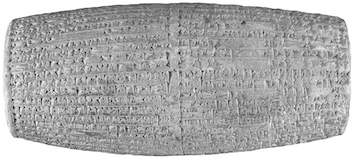Neriglissar (r. 559–556 BC)

Loan Ant-43, a two-column clay cylinder purchased at Babylon by Sir John Malcolm ca. 1811 and now on display in the Fitzwilliam Museum in Cambridge. The Akkadian inscription written on it records the manufacture of copper mušhuššu-dragons for a few prominent gateways of Marduk's temple Esagil. Credit: Fitzwilliam Museum.
Neriglissar was not in the direct line of succession, as he was not the son of Nebuchadnezzar II or of his immediate predecessor Amēl-Marduk. Instead, he was the son of the Aramaean tribal leader Bēl-šum-iškun and an influential and wealthy landowner who became the important simmagir-official of Nebuchadnezzar and later married one of the king's daughters (possibly Kaššaya). After deposing Amēl-Marduk and seizing control of the Babylonian throne, Neriglissar sponsored several building activities in some of Babylonia's most important cult centers, Babylon, Borsippa, and Sippar. From textual sources, mostly royal inscriptions written in Akkadian, this ruler is known to have sponsored construction on the following:
- Babylon
- Esagil (temple of the god Marduk)
- Ka-hegal (western gate of the main temple of Esagil)
- Ka-Lamma-arabi (northern gate of the main temple of Esagil)
- Ka-ude-babbar (southern gate of the main temple of Esagil)
- Ka-Utu-e (eastern gate of the main temple of Esagil)
- Lībil-hegalla (the eastern canal)
- South Palace
- Borsippa
- Dais of Destinies (a seat of the god Nabû in the Ezida temple complex)
- Ezida (temple of the god Nabû)
- Sippar
- Ekunankuga (ziggurat of the god Šamaš)
Jamie Novotny & Niclas Dannehl
Jamie Novotny & Niclas Dannehl, 'Neriglissar (r. 559–556 BC)', Babylonian Temples and Monumental Architecture online (BTMAo), The BTMAo Project, a sub-project of MOCCI, [http://oracc.org/btmao/StructuresbyBuilder/Neo-BabylonianEmpire/Neriglissar/]